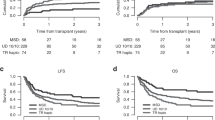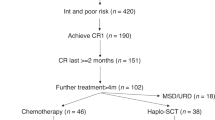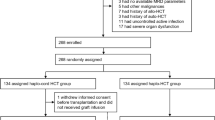Abstract
Despite advancements in treatment, the prognosis for elderly AML patients remains poor. We conducted a retrospective study involving 307 consecutive AML patients, including 71 who underwent haploidentical hematopoietic cell transplantation (Haplo) and 236 who received chemotherapy (Chemo) only. Propensity score matching with 1:1 ratio was performed to balance the groups based on age at treatment initiation, gender, and European Leukemia Net (ELN) 2022 risk classification. 69 case-controlled pairs in the Haplo and Chemo group were analyzed after matching. The two groups were comparable concerning therapy prior to complete remission and 72.5% of patients in the Haplo group received reduced-intensity conditioning. Haplo was associated with a significant survival advantage over Chemo, with a 1-year OS of 77.9% (95% confidence interval(CI), 65.5–86.3, p = 0.001) versus 62.0% (95% CI, 47.9–73.2, p = 0.009). A significanly higher 1-year LFS of 74.1% (95% CI, 61.5–83.1) was also observed compared with 42.0% (95% CI, 29.3–54.0) in the chemotherapy group (p < 0.0001). The survival advantage was majorly due to a significantly reduced relapse incidence (Haplo: 16.5% (95% CI, 8.7–26.5) vs Chemo: 56.6% (95% CI, 42.9–68.2)). The 1-year non-relapse mortality was 9.4% (95% CI, 3.8–18.2) in the Haplo group. To conclude, haploidentical HCT showed superior outcomes to chemotherapy alone and might be recommended to AML patients 55 years or older eligible for transplant in future practice.
This is a preview of subscription content, access via your institution
Access options
Subscribe to this journal
Receive 12 print issues and online access
$259.00 per year
only $21.58 per issue
Buy this article
- Purchase on SpringerLink
- Instant access to full article PDF
Prices may be subject to local taxes which are calculated during checkout


Similar content being viewed by others
Data availability
Data available on request from the authors.
References
Klepin HD, Rao AV, Pardee TS. Acute myeloid leukemia and myelodysplastic syndromes in older adults. J Clin Oncol. 2014;32:2541–52. https://doi.org/10.1200/JCO.2014.55.1564.
Linet MS, Curtis RE, Schonfeld SJ, Vo JB, Morton LM, Dores GM. Survival of adult AML patients treated with chemotherapy in the U.S. population by age, race and ethnicity, sex, calendar-year period, and AML subgroup, 2001-2019. EClinicalMedicine. 2024;71:102549 https://doi.org/10.1016/j.eclinm.2024.102549.
Versluis J, Hazenberg CL, Passweg JR, van Putten WL, Maertens J, Biemond BJ, et al. Post-remission treatment with allogeneic stem cell transplantation in patients aged 60 years and older with acute myeloid leukaemia: a time-dependent analysis. Lancet Haematol. 2015;2:e427–436. https://doi.org/10.1016/S2352-3026(15)00148-9.
Devine SM, Owzar K, Blum W, Mulkey F, Stone RM, Hsu JW, et al. Phase II Study of Allogeneic Transplantation for Older Patients With Acute Myeloid Leukemia in First Complete Remission Using a Reduced-Intensity Conditioning Regimen: Results From Cancer and Leukemia Group B 100103 (Alliance for Clinical Trials in Oncology)/Blood and Marrow Transplant Clinical Trial Network 0502. J Clin Oncol. 2015;33:4167–75. https://doi.org/10.1200/jco.2015.62.7273.
Shimoni A, Labopin M, Savani B, Volin L, Ehninger G, Kuball J, et al. Long-term survival and late events after allogeneic stem cell transplantation from HLA-matched siblings for acute myeloid leukemia with myeloablative compared to reduced-intensity conditioning: a report on behalf of the acute leukemia working party of European group for blood and marrow transplantation. J Hematol Oncol. 2016;9:118 https://doi.org/10.1186/s13045-016-0347-1.
Chang YJ, Zhao XY, Xu LP, Zhang XH, Wang Y, Han W, et al. Donor-specific anti-human leukocyte antigen antibodies were associated with primary graft failure after unmanipulated haploidentical blood and marrow transplantation: a prospective study with randomly assigned training and validation sets. J Hematol Oncol. 2015;8:84 https://doi.org/10.1186/s13045-015-0182-9.
Ye Y, Labopin M, Chen J, Wu D, Gedde-Dahl T Sr, Blaise D, et al. Lower relapse incidence with HAPLO versus MSD or MUD HCTs for AML patients with KMT2A rearrangement: a study from the Global Committee and the ALWP of the EBMT. Blood Cancer J. 2024;14:85 https://doi.org/10.1038/s41408-024-01072-0.
Sanz J, Galimard JE, Labopin M, Afanasyev B, Angelucci E, Ciceri F, et al. Post-transplant cyclophosphamide after matched sibling, unrelated and haploidentical donor transplants in patients with acute myeloid leukemia: a comparative study of the ALWP EBMT. J Hematol Oncol. 2020;13:46 https://doi.org/10.1186/s13045-020-00882-6.
Gorin NC, Labopin M, Blaise D, de Groot M, Socié G, Bourhis JH, et al. Stem cell transplantation from a haploidentical donor versus a genoidentical sister for adult male patients with acute myelogenous leukemia in first remission: A retrospective study from the acute leukemia working party of the European Society for Blood and Marrow Transplantation. Cancer. 2020;126:1004–15. https://doi.org/10.1002/cncr.32629.
DiNardo CD, Jonas BA, Pullarkat V, Thirman MJ, Garcia JS, Wei AH, et al. Azacitidine and Venetoclax in Previously Untreated Acute Myeloid Leukemia. N Engl J Med. 2020;383:617–29. https://doi.org/10.1056/NEJMoa2012971.
Döhner H, Wei AH, Appelbaum FR, Craddock C, DiNardo CD, Dombret H, et al. Diagnosis and management of AML in adults: 2022 recommendations from an international expert panel on behalf of the ELN. Blood. 2022;140:1345–77. https://doi.org/10.1182/blood.2022016867.
Zimmer M, Kadia T. Approach to the Older Patient with Acute Myeloid Leukemia. Curr Oncol Rep. 2023;25:1203–11. https://doi.org/10.1007/s11912-023-01450-0.
Kantarjian H. Acute myeloid leukemia-major progress over four decades and glimpses into the future. Am J Hematol. 2016;91:131–45. https://doi.org/10.1002/ajh.24246.
Appelbaum FR, Gundacker H, Head DR, Slovak ML, Willman CL, Godwin JE, et al. Age and acute myeloid leukemia. Blood. 2006;107:3481–5. https://doi.org/10.1182/blood-2005-09-3724.
Medeiros BC, Satram-Hoang S, Hurst D, Hoang KQ, Momin F, Reyes C. Big data analysis of treatment patterns and outcomes among elderly acute myeloid leukemia patients in the United States. Ann Hematol. 2015;94:1127–38. https://doi.org/10.1007/s00277-015-2351-x.
Vasu S, Kohlschmidt J, Mrózek K, Eisfeld AK, Nicolet D, Sterling LJ, et al. Ten-year outcome of patients with acute myeloid leukemia not treated with allogeneic transplantation in first complete remission. Blood Adv. 2018;2:1645–50. https://doi.org/10.1182/bloodadvances.2017015222.
Farag SS, Maharry K, Zhang MJ, Pérez WS, George SL, Mrózek K, et al. Comparison of reduced-intensity hematopoietic cell transplantation with chemotherapy in patients age 60-70 years with acute myelogenous leukemia in first remission. Biol Blood Marrow Transplant. 2011;17:1796–803. https://doi.org/10.1016/j.bbmt.2011.06.005.
Ustun C, Le-Rademacher J, Wang HL, Othus M, Sun Z, Major B, et al. Allogeneic hematopoietic cell transplantation compared to chemotherapy consolidation in older acute myeloid leukemia (AML) patients 60-75 years in first complete remission (CR1): an alliance (A151509), SWOG, ECOG-ACRIN, and CIBMTR study. Leukemia. 2019;33:2599–609. https://doi.org/10.1038/s41375-019-0477-x.
Devillier R, Forcade E, Garnier A, Guenounou S, Thepot S, Guillerm G, et al. In-depth time-dependent analysis of the benefit of allo-HSCT for elderly patients with CR1 AML: a FILO study. Blood Adv. 2022;6:1804–12. https://doi.org/10.1182/bloodadvances.2021004435.
Bazarbachi A, Labopin M, Moukalled N, Kröger N, Rautenberg C, Schetelig J, et al. Improvements in Posttransplant Outcomes Over Two Decades in Older Patients with Acute Myeloid Leukemia in the EBMT ALWP Study. Clin Cancer Res. 2024;30:1778–87. https://doi.org/10.1158/1078-0432.ccr-23-3673.
Ye Y, Labopin M, Gerard S, Yakoub-Agha I, Blau IW, Aljurf M, et al. Lower relapse incidence with haploidentical versus matched sibling or unrelated donor hematopoietic cell transplantation for core-binding factor AML patients in CR2: A study from the Global Committee and the Acute Leukemia Working Party of the European Society for Blood and Marrow Transplantation. Am J Hematol. 2024;99:1290–9. https://doi.org/10.1002/ajh.27342.
Muffly L, Pasquini MC, Martens M, Brazauskas R, Zhu X, Adekola K, et al. Increasing use of allogeneic hematopoietic cell transplantation in patients aged 70 years and older in the United States. Blood. 2017;130:1156–64. https://doi.org/10.1182/blood-2017-03-772368.
Maffini E, Ngoya M, Galimard JE, Harbi S, Kröger N, Platzbecker U, et al. Allogeneic hematopoietic cell transplantation for patients with AML aged 70 years or older in first remission. A study from the Acute Leukemia Working Party of the European Society for Blood and Marrow Transplantation (EBMT). Bone Marrow Transplant. 2023;58:1033–41. https://doi.org/10.1038/s41409-023-02027-y.
Santoro N, Labopin M, Giannotti F, Ehninger G, Niederwieser D, Brecht A, et al. Unmanipulated haploidentical in comparison with matched unrelated donor stem cell transplantation in patients 60 years and older with acute myeloid leukemia: a comparative study on behalf of the ALWP of the EBMT. J Hematol Oncol. 2018;11:55 https://doi.org/10.1186/s13045-018-0598-0.
Ciurea SO, Shah MV, Saliba RM, Gaballa S, Kongtim P, Rondon G, et al. Haploidentical Transplantation for Older Patients with Acute Myeloid Leukemia and Myelodysplastic Syndrome. Biol Blood Marrow Transplant. 2018;24:1232–6. https://doi.org/10.1016/j.bbmt.2017.09.005.
Maakaron JE, Zhang MJ, Chen K, Abhyankar S, Bhatt VR, Chhabra S, et al. Age is no barrier for adults undergoing HCT for AML in CR1: contemporary CIBMTR analysis. Bone marrow Transplant. 2022;57:911–7. https://doi.org/10.1038/s41409-022-01650-5.
Vo PT, Sandmaier BM, Othus M, Ali N, Rodríguez-Arbolí E, Orvain C et al. Relationship between age, conditioning intensity, and outcome after allografting in adults age ≥60 years with AML. Bone Marrow Transplant. 2025, https://doi.org/10.1038/s41409-025-02516-2.
Zhang XH, Chen J, Han MZ, Huang H, Jiang EL, Jiang M, et al. The consensus from The Chinese Society of Hematology on indications, conditioning regimens and donor selection for allogeneic hematopoietic stem cell transplantation: 2021 update. J Hematol Oncol. 2021;14:145 https://doi.org/10.1186/s13045-021-01159-2.
Acknowledgements
We would like to express our gratitude to all the patients and personnel involved in this study.
Author information
Authors and Affiliations
Contributions
He Huang, Xi Zhang and Yishan Ye contributed to the study conception and design. Data collection and analysis were performed by Lin Li, Lixia Zhu, Mengqi Xiong and Zhile Chen. The first draft was written by Lin Li and all authors commented on previous versions of the manuscript. All authors read and approved the final manuscript.
Corresponding authors
Ethics declarations
Competing interests
The authors declare no competing interests.
Ethics approval and consent to participate
All methods were performed in accordance with the relevant guidelines and regulations. Ethical approval was obtained from the Clinical Research Ethics Committee of the First Affiliated Hospital, Zhejiang University School of Medicine and Medical Center of Hematology, Xinqiao Hospital of Army Medical University, Chongqing, China. Informed consent was obtained from all participants prior to their involvement in the study.
Additional information
Publisher’s note Springer Nature remains neutral with regard to jurisdictional claims in published maps and institutional affiliations.
Supplementary information
Rights and permissions
Springer Nature or its licensor (e.g. a society or other partner) holds exclusive rights to this article under a publishing agreement with the author(s) or other rightsholder(s); author self-archiving of the accepted manuscript version of this article is solely governed by the terms of such publishing agreement and applicable law.
About this article
Cite this article
Li, L., Zhu, L., Xiong, M. et al. Superior outcomes of haploidentical hematopoietic cell transplantation over chemotherapy in AML patients 55 years or older. Bone Marrow Transplant 60, 773–778 (2025). https://doi.org/10.1038/s41409-025-02560-y
Received:
Revised:
Accepted:
Published:
Issue date:
DOI: https://doi.org/10.1038/s41409-025-02560-y



